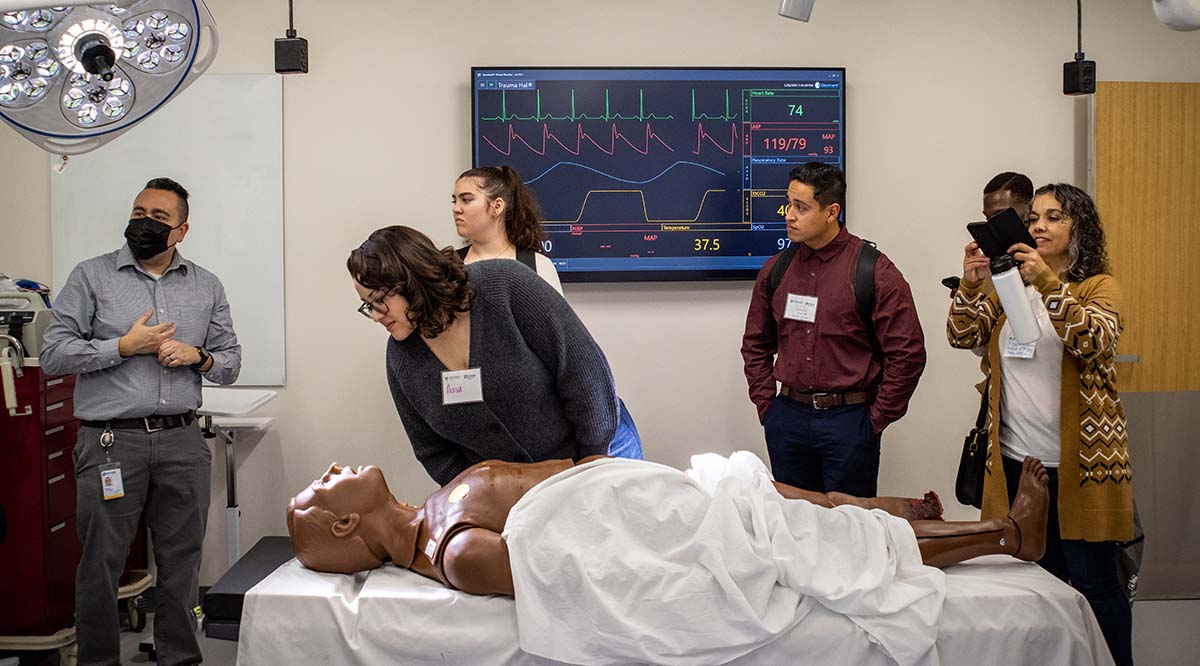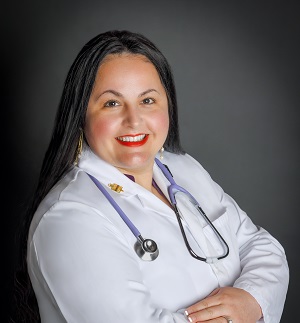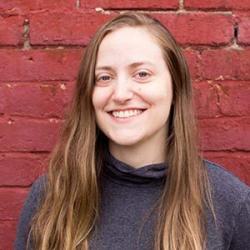
When Jessica de Laguna was growing up in foster care near San Francisco, she felt no one had time to help her focus on what she wanted to be when she grew up.
“I just learned to survive,” says de Laguna, who identifies as a Native American of the Yaqui Tribe.
After graduating from high school, de Laguna was more focused on getting a job that could help pay her bills than thinking about applying to college. She was working at a bank when her experience helping a blind neighbor attend her physical therapy appointments sparked an interest in medicine.
Without a college degree — and with volunteering as a physical therapy aide her only medical experience — de Laguna started her career in the medical field as a receptionist for a student health clinic. She then worked her way up to a position as a care coordinator at a hospital, taking extra shifts to work in various departments from emergency medicine to neurosurgery.
“I worked in every department possible so I could learn as much as I could without going to medical school,” de Laguna says.
After eight years working at the hospital, she thought, “I could be a doctor by now.”
The thought inspired her to research what it would take for her to complete a bachelor’s degree and get accepted to medical school, where she hopes to become a psychiatrist and physician-scientist engaged in mental health research to help people like herself who have experienced childhood trauma.
In 2021, after 15 years away from the classroom, de Laguna decided to go all-in on her dream of becoming a doctor and enrolled as a full-time student at Sacramento City College and American River College, both part of the California Community Colleges System, where she is double majoring in biology and chemical technology.
It was through the community college system that she learned of AvenueM, a new program at the University of California, Davis (UC Davis) School of Medicine aimed at recruiting community college students and supporting them on a path to medical school. The program’s goal is to diversify the physician workforce and fill a need in medically underserved communities.
“Once you get a student to apply, there’s a real effort to fully assess them for their capabilities outside of [the fact] that they went to community college and see that not as a drawback, but instead, see that as a value.”
Efrain Talamantes, MD, chief operating officer, AltaMed Health Services
“We really started to look more at the path before medical school,” says Charlene Green, PsyD, assistant dean of admissions, outreach, and diversity at the UC Davis School of Medicine. “This is all long-game work, but we’ve really tried to enhance the pool of applicants who … have that personal mission to care for these specific communities that we’re targeting here in California.”
It’s a strategy several medical schools are taking as they attempt to find solutions to the worsening physician shortage and the barriers medically underserved communities face to accessing health care.
Some advocates of the approach hope that it can help counteract any biases or disadvantages students who attended a community college might face when applying to medical school.
“I serve on various medical school admissions committees and boards as a volunteer, and I think one thing that we do see is — not only are community college students taken more seriously [than in previous years] — but there’s a real appreciation for the value they bring to the campus,” says Efrain Talamantes, MD, chief operating officer of AltaMed Health Services, a community health network based in southern California, and former associate director of the UC Davis Center for Reducing Health Disparities. “Once you get a student to apply, there’s a real effort to fully assess them for their capabilities outside of [the fact] that they went to community college and see that not as a drawback, but instead, see that as a value.”
Reaching the underrepresented
For Talamantes, the mission to expand opportunities for community college students is a personal one. As someone who attended community college himself before medical school, he has long advocated for removing barriers for others like him.
“When I was going through medical school and participating in admissions committees, it was clear to me that there was a bias [against] those who attended community college and there was a lot more emphasis placed on those who went directly to a four-year university,” Talamantes recalls. “So I really started to ask why and try to understand what we could do about it.”
In 2014, Talamantes and several other researchers analyzed medical school applicant and admissions data and found that people who had attended a community college before graduating from a four-year university had a lower chance of being accepted to medical school compared to students who went straight to a four-year university. In a 2018 study, Talamantes and his colleagues found that students who attended a community college before medical school were more likely to pursue a family medicine specialty and to want to work in medically underserved communities.
“We found that not only were these students from underrepresented backgrounds, but many of them were lower income or first in their families to attend college as well,” Talamantes says. “So that validated that there’s a pool of great candidates in community colleges. And that set us on a different path, which was: How do we work with medical schools to create true partnerships with community colleges?”
A localized approach
When he worked for the UC Davis Center for Reducing Health Disparities, Talamantes helped foster relationships with community colleges in the Sacramento area, laying the foundation for what has become AvenueM and the California Medicine Scholars Program. The initiative, launched in 2022 with state and philanthropic funding, aims to strengthen regional hubs that had ongoing partnerships with local community colleges and to support newer hubs in growing their programs and developing new partnerships.
There are four California regional hubs, which are made up of medical schools, community colleges, health clinics, and other local service providers, each in a different stage of development, says Rowena Robles, PhD, executive director of the California Medicine Scholars Program.
“The regional focus is so that the institutions are familiar with that region, those students, and their needs,” she explains.
The programs are specifically adapted to work for local community members, from holding medical school interest meetings on weekends and inviting family to attend to ensuring outreach grounded in cultural humility, Robles says.
“Rather than us waiting for them to get to school [and] to apply to medical school, we’re saying, ‘Hey, we think you’re great. You’re the exact type of student we want to see as a doctor in California and a medical student at UC Davis.'”
Tonya Fancher, MD, associate dean for workforce innovation and community engagement, UC Davis School of Medicine
They also emphasize “warm handoffs,” meaning that students selected to the pathway programs will have mentorship and supportive staff and faculty, with services and programs tailored to their needs throughout the process — from community college to four-year university and then on to medical school.
De Laguna is part of the first cohort of students benefiting from the California Medicine Scholars Program, which funds UC Davis’s AvenueM initiative. She has encountered the difference that good mentorship can make when her chemistry professor took the time to help her hone her studying skills and introduce her to medical research. She’s now working with undergraduate researchers on a cure for Alzheimer’s disease, focusing on keeping up good grades in her classes, and participating in extracurricular activities that will help her prepare to transfer to UC Davis in 2024 to complete her bachelor’s degree, and, if all goes to plan, start medical school in 2026.

By being part of the AvenueM pathway program, she feels confident she will get the support she needs to fulfill her dream of becoming a doctor.
“They’ll meet you where you are. If you want to be a doctor, they’ll help you get there. A lot of the application process is so they can see through people’s numbers — their MCAT score and their GPA — and see who you are as a person,” de Laguna says. “And I think that one thing that has brought me through is people seeing my drive and my passion and who I am as a person and thinking, ‘Okay, I can go places with her.’”
Including de Laguna, UC Davis has enrolled 30 students from local community colleges to the AvenueM program and hopes to add an additional 20 to this first cohort in the coming months.
“Rather than us waiting for them to get to school [and] to apply to medical school, we’re saying, ‘Hey, we think you’re great. You’re the exact type of student we want to see as a doctor in California and a medical student at UC Davis. So let’s meet and work together and take this journey together,’” says Tonya Fancher, MD, associate dean for workforce innovation and community engagement at UC Davis School of Medicine. “It’s a lot of effort, no question, but it’s worth it.”
And it’s this localized focus that Fancher and others involved in developing these outreach programs hope will eventually result in healthier communities.
“We believe that a workforce that is more reflective of our community provides better care,” Fancher says. “It’s on us to create that bridge back to the community.”
